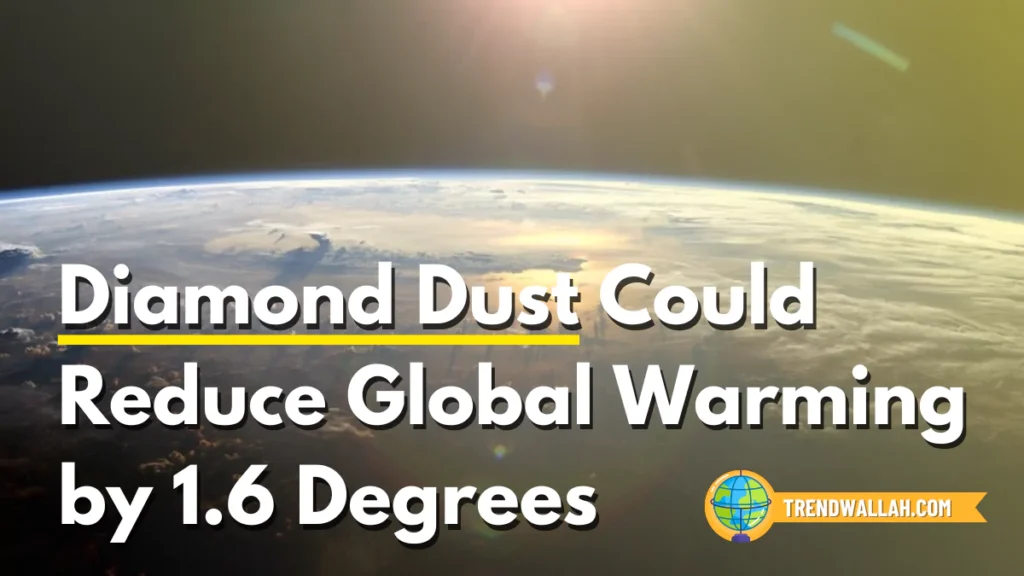
Diamond Dust Reduce Global Warming- A recent study published in Geophysical Research Letters suggests that injecting diamond dust into the stratosphere could effectively reduce global temperatures. Researchers propose that spraying five million tons of diamond particles into the atmosphere annually could help cool the Earth by 1.6 degrees Celsius.
Inspiration From Volcanic Eruptions
Scientists were inspired by past volcanic eruptions, which released particles into the stratosphere, leading to temporary cooling effects. One notable example is the 1991 eruption of Mount Pinatubo in the Philippines, which cooled the planet by 0.5 degrees for several years.
The Idea Behind Diamond Dust
Diamond particles can reflect sunlight and reduce heat, preventing the Earth from warming. Unlike sulfur, diamonds do not react to form harmful acids, making them a safer choice for geoengineering.
Comparison of Potential SRM Materials
| Material | Benefits | Drawbacks |
| Diamond | High reflectivity, long-lasting, safe | Extremely costly, $200 trillion |
| Sulfur | Affordable, effective at cooling | Can cause acid rain, disrupt climate |
| Calcite | Reflective, potentially safer than sulfur | Still under research |
| Aluminum | High reflectivity, light in weight | Limited studies on long-term effects |
Solar Geoengineering: Using the Stratosphere to Cool Earth
Geoengineering involves large-scale interventions in the Earth’s natural systems to counter global warming. The method of spraying particles to reflect sunlight back into space is known as Solar Radiation Management (SRM). This technique has gained attention as a possible way to slow down climate change.
Previous Attempts and Current Research
Earlier studies explored materials like sulfur, calcite, and aluminum for SRM, but each had its drawbacks. Sulfur, despite being affordable, risks causing acid rain and disrupting weather patterns. Scientists at ETH Zurich experimented with diamond dust, finding it to be a safer and more effective option.
The Cost of Diamond Dust for Climate Control
Although diamond particles may work effectively, the cost is enormous. Annual injections of diamond dust would require around $200 trillion, making it 2,400 times more expensive than using sulfur. Despite the costs, researchers believe further studies could lead to more affordable solutions.
Diamond Dust Reduces Global Warming- Summary
- Researchers propose using diamond dust to cool Earth by 1.6 degrees.
- Diamond dust reflects sunlight without causing harmful reactions.
- The method, called stratospheric aerosol injection, mimics the cooling effect of volcanic eruptions.
- Previous SRM options, like sulfur, have significant environmental risks.
- The study suggests spraying 5 million tons of diamond dust annually.
- The cost is estimated at $200 trillion, much higher than other materials.
- Research emphasizes the importance of finding sustainable and safe geoengineering solutions.
Also Read Latest Current Affairs 2024
Researchers suggest that diamond dust can reflect sunlight, reducing heat and potentially lowering Earth’s temperature by 1.6 degrees.
Unlike sulfur, which can cause acid rain and disrupt weather patterns, diamond dust does not react with other substances and remains safe.
Diamond particles reflect sunlight back into space, preventing excess heat from warming the planet, similar to how volcanic eruptions create a cooling effect.
The major drawback is cost. Using diamond dust could require about $200 trillion, making it an expensive option compared to other materials.
SRM is a geoengineering technique that involves spraying particles into the stratosphere to reflect sunlight and cool the Earth.
Volcanic eruptions release particles into the atmosphere, causing a temporary cooling effect. Researchers were inspired by this natural process to explore similar solutions.
Yes, earlier studies looked into sulfur, calcite, and aluminum, but each has specific drawbacks that make them less ideal than diamonds.
